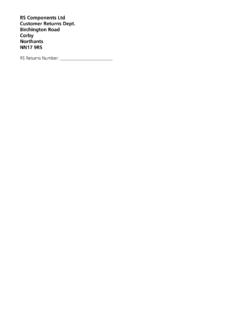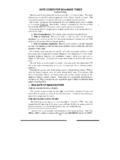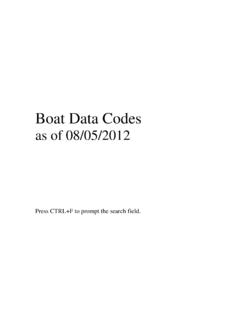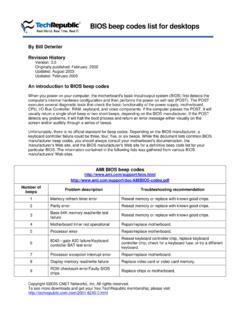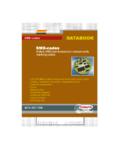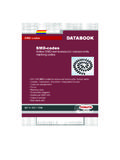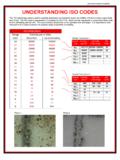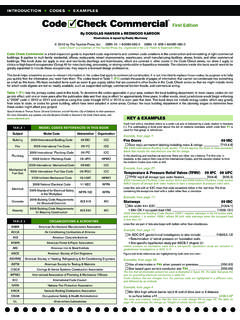Transcription of GUIDE TO THE ‘IP’ CODES FOR ENCLOSURES
1 GUIDE TO THE. IP' CODES FOR. ENCLOSURES . Third Edition DEGREE OF PROTECTION. BS EN 60529: 1992 (IEC 529 1989). The Electrical Installation Equipment manufacturers ' Association INTRODUCTION TO EIEMA. T he Electrical Installation Equipment manufacturers ' Association is an independent, incorporated Association of manufacturers of electrical installation equipment whose roots go back to the early days of the electrotechnical industry. In 1972 EIEMA. Limited was formed from the Electrical Installation Equipment Department of BEAMA. The British Electrotechnical and Allied manufacturers ' Association. EIEMA has 45 members ranging from companies which are the UK Divisions of large multinational companies to small owner managed niche market companies. EIEMA is organised into four Product Groups as follows: Single Phase Product Group (SPPG). Wiring Accessories, MCBs, RCDs, Power Track, Consumer Units. Industrial Products Group (IPG).
2 Fuses, Distribution Boards (standard), Switch & Fusegear, MCCBs (as well as MCBs and RCDs), ACBs, Industrial Plugs and Sockets. Engineered Product Systems Group (EPSG). Low Voltage Switchboards, Busduct products. Cutout & Feeder Pillar Group (COFP). Cutouts, Feeder Pillars. The benefits of membership fall into two broad categories which are representation and access to Association services. The main areas in which the Association represents its members are in legislative and standardisation matters. The former is done both directly by established relationships with appropriate Government or EU departments in London and Brussels, and through BEAMA and various European manufacturers ' groups. Active participation in the work of numerous national, international and European standards committees has provided the background and support to ensure safety and performance for the design, development and manufacture of EIEMA members'.
3 Products. The result is quality equipment of the highest standard throughout each group of the Association. Other services offered by the Association include legal, statistics and export support. In addition the Association is a channel for liaison with customer associations such as the Electrical Distributors' Association (EDA) and the Electrical Contractors' Association (ECA). Acknowledgements EIEMA would like to thank: IEC and BSI for allowing references to their standards. CONTENTS. Section Page An Introduction to EIEMA. Preface 2. 1 Introduction 3. 2 Scope 4. 3 Object 4. 4 Designations 6. 5 Selection 7. 6 IP CODES 9. 7 Weatherproof applications 11. 8 Drainage holes 12. 9 Ventilated equipment 13. 10 Empty ENCLOSURES 13. 11 Typical examples 14. This publication is available at 10 plus postage and packing. PREFACE T he object of this GUIDE is to provide an easily understood document, aiding interpretation of the requirements for enclosure protection related to EIEMA.
4 Products. Principally, these requirements are detailed in BS EN 60529:1992 (IEC 60529:1989. second edition) which defines the degrees of protection provided by ENCLOSURES classified under the International Protection (IP) code and the test conditions required to meet these classifications. This GUIDE should be read in conjunction with those documents. Readers should note, the requirements in the Standard call for comparative tests and these bear no actual relationship to specific weather or corrosive conditions. The GUIDE seeks to provide a simplified understanding of the standard, accompanied by some typical examples as foreseen for the general products available from EIEMA. member Companies. As BS EN 60529 is a document covering a wide range of IP1X dia sphere no penetration equipment, only those sections relevant to EIEMA products are covered. Certain additional information has been included having regard to the particular considerations necessary for equipment intended for exposure to weather and to the requirement for natural ventilation, which exists with some products.
5 It is the intention of EIEMA to review this GUIDE periodically, to reflect changes in related specific- ations, product standards and working practices. 2. 1. INTRODUCTION. B S EN 60529 describes a system for classifying degrees of protection provided by ENCLOSURES , principally for electrical equipment. It should be noted that empty ENCLOSURES may be supplied and therefore could be used for other applications. Whilst this system is suitable for use with most types of electrical equipment, it should not be assumed that all the listed degrees of protection are applicable to a particular type of equipment. The manufacturer of the equipment or enclosure should be consulted to determine the degree of protection available and the parts of equipment to which the stated degree of protection applies, if this is not clearly stated in the literature or on the enclosure . It is particularly important where ENCLOSURES need to be adapted or modified by the user for the attachment of other equipment or for installation and cabling, that any instructions provided by the enclosure manufacturer should be strictly observed, to ensure the required degree of protection is maintained.
6 BS EN 60529 provides for an optional extension of the IP code by single additional letters A, B, C or D if the actual protection of persons against access to hazardous parts is higher than that indicated by the first characteristic numeral. This particularly applies to ventilated equipment where internal barriers etc., give added protection for personnel, and this consideration was not included in the First Edition of the standard. IP2X Test finger Designation with a degree of protection implies that the enclosure also complies with all the lower degrees except for the immersion categories. In general the higher the IP code , the more expensive the enclosure , but specifying a higher degree of protection does not necessarily ensure it is the most suitable for a particular app- lication. For instance ventilation reduces the possibility of internal condensation (See sections 7, 8 & 9). It may also be necessary to de-rate equipment, which relies upon natural ventilation if a sealed enclosure is required.
7 3. 2. SCOPE T he code letters IP of BS EN 60529 refer to International Protection as applicable to ENCLOSURES of electrical equipment with a rated voltage not exceeding It should be noted that this standard is also applicable to empty ENCLOSURES provided that the general test requirements are met and that the selected degree of protection is suitable for the type of equipment to be enclosed. The majority of EIEMA products are required to conform to the Low Voltage Directive. This GUIDE is therefore only intended to describe the classifications for degrees of protection provided by ENCLOSURES of electrical equipment with a rated voltage not exceeding 1000V ac and 1500V dc. 3. OBJECT D egrees of protection are classified in three general categories. 1) Protection of persons against access to hazardous parts inside ENCLOSURES . This is intended to cover protection of persons against accidental contact with electrically live' or otherwise hazardous mechanical parts contained within the enclosure , rotating blades, switch mechanisms etc.
8 2) Protection of the equipment inside the enclosure against the ingress of solid foreign objects. Intended to cover protection of the equipment mounted inside against tools, and/or strands of wire and/or the harmful ingress of dust particles. Barriers, shapes of openings or any other means - whether attached to the enclosure or formed by the enclosed equipment - suitable to prevent or limit the penetration of the specified test probes are considered as a part of the enclosure , except when they can be removed without the use of a key or tool. 3) Protection of the equipment inside the enclosure against harmful ingress of water. Intended to cover protection of equipment from harmful effects due to dripping, spraying, splashing and hosing or total immersion. It should be noted that the specified degrees of protection in this third area of BS EN 60529. do not include a strict classification for weather resis- tance, corrosion prevention, or resistance to other physically hazardous conditions.
9 IP3X probe 4. BS EN 60529 states in clause 2, that measures to protect against, mechanical impact solar radiation corrosion icing corrosive solvents moisture (condensation). fungus explosive atmospheres vermin contact with moving parts external to the enclosure are not considered and should form part of the product specification where relevant. Where an enclosure needs to be machined or adapted for the attachment of cable glands, conduit or any other equipment, any instructions provided by the enclosure manufacturer should be strictly observed to ensure the required degree of protection is maintained. Although not a part of BS EN 60529, some general notes on weather resistance, drainage holes and the need for natural ventilation in certain products are included in sections 7, 8 and 9 of this GUIDE . IPX1 Vertically dripping 5. 4. DESIGNATIONS T he degrees of protection provided by an enclosure are indicated by the IP code in the following way: code LETTERS IP 2 3 D W.
10 International Protection FIRST NUMERAL 0-6, or letter X. Protection of persons by prevention or limiting ingress of parts of the human body or solid objects SECOND NUMERAL 0-8, or letter X. Resistance to ingress of water ADDITIONAL LETTER (Optional). Enhanced personnel protection, see section 6. A: up to the guard/stop face of sphere B: up to the guard/stop face of test finger C: up to the guard/stop face of x probe D: up to the guard/stop face of x probe SUPPLEMENTARY LETTER (Optional). For specific applications. H: High voltage equipment M: Moving or rotating equipment (Tested whilst in motion). S: Moving or rotating equipment (Tested whilst at rest) Note: H, M & S are not W: Weather conditions generally applicable to (Agreed between Manufacturer and User) EIEMA products. X' Letter The letter X' is used in place of the first or second numeral by equipment manufacturers to indicate that tests are not applicable to the product1.
